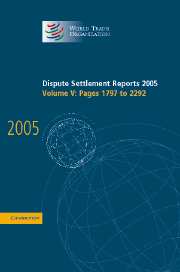United States – Subsidies on Upland Cotton (WT/DS267): Table of Annex I-12 to Annex I-28
Published online by Cambridge University Press: 13 December 2017
Summary
BRAZIL's INTRODUCTORY COMMENTS
Brazil's response to the US 22 December 2003 Comments Concerning Brazil's Econometric Model (“US Critique”) is divided into two parts. First, Brazil provides some introductory comments setting the US Critique into perspective. And, second, Brazil offers Professor Sumner's detailed response to the US critique.
The United States Critique initially focuses on proving a point that has never been contested by Brazil, i.e., that the Sumner model is not exactly like the FAPRI model. As Professor Sumner points out, he never claimed that his model was identical to the FAPRI model. The United States points to no contradictions between what Professor Babcock has stated and what Professor Sumner stated in Annex I or his other statements concerning the links between his model and the FAPRI model. Nevertheless, while there are differences between the Sumner model and the FAPRI model, the record is undisputed that the core elements of the FAPRI model – the hundreds of demand and supply equations – are identical. The differences in Professor Sumner's model are primarily the result of his use of the CARD international cotton model and additions to the FAPRI model made by Professor Sumner. The additions were necessary to enable the FAPRI/CARD modelling framework to respond to the questions before this Panel.
The United States Critique asserts that Professor Sumner's choice of baselines has prejudiced the outcome to such an extent that his results are not usable. But the record shows that the significant acreage, production, export and price effects found in Professor Sumner's Annex I results using the CARD international cotton model and the amended FAPRI US crops model based off the (recalibrated) FAPRI preliminary November 2002 baseline are essentially the same even when used against other baselines. The United States first argued that Professor Sumner should have used the FAPRI 2003 baseline. Professor Sumner responded by running his model on that later baseline. There were no significant changes between Annex I and those results for either the period from MY 1999- 2002 or in the period from MY 2003-2007. The United States Critique raises a new argument that Professor Sumner manipulated the FAPRI preliminary November 2002 baseline.
- Type
- Chapter
- Information
- Dispute Settlement Reports 2005 , pp. 1799 - 2292Publisher: Cambridge University PressPrint publication year: 2007
- 1
- Cited by

